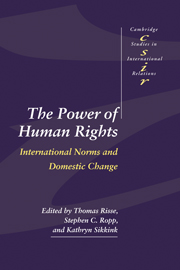Book contents
- Frontmatter
- Contents
- List of contributors
- Preface
- 1 The socialization of international human rights norms into domestic practices: introduction
- 2 Transnational activism and political change in Kenya and Uganda
- 3 The long and winding road: International norms and domestic political change in South Africa
- 4 Changing discourse: transnational advocacy networks in Tunisia and Morocco
- 5 Linking the unlinkable? International norms and nationalism in Indonesia and the Philippines
- 6 International norms and domestic politics in Chile and Guatemala
- 7 The Helsinki accords and political change in Eastern Europe
- 8 International human rights norms and domestic change: conclusions
- List of references
- Index
- Cambridge Cultural Social Studies
8 - International human rights norms and domestic change: conclusions
Published online by Cambridge University Press: 07 December 2009
- Frontmatter
- Contents
- List of contributors
- Preface
- 1 The socialization of international human rights norms into domestic practices: introduction
- 2 Transnational activism and political change in Kenya and Uganda
- 3 The long and winding road: International norms and domestic political change in South Africa
- 4 Changing discourse: transnational advocacy networks in Tunisia and Morocco
- 5 Linking the unlinkable? International norms and nationalism in Indonesia and the Philippines
- 6 International norms and domestic politics in Chile and Guatemala
- 7 The Helsinki accords and political change in Eastern Europe
- 8 International human rights norms and domestic change: conclusions
- List of references
- Index
- Cambridge Cultural Social Studies
Summary
Introduction
In adopting the Universal Declaration of Human Rights on December 10,1948, the delegates to the United Nations General Assembly established a common set of principles against which the human rights practices of individual member states could be measured. Although these principles were not initially binding on UN member states, they included the seeds of an international legal system in the realm of human rights. In the meantime and following the Universal Declaration, a global human rights regime has emerged consisting of numerous international conventions, specific international organizations to monitor compliance, and regional human rights arrangements (see Alston 1992; Donnelly 1986; Forsythe 1991). Moreover, the global human rights regime has led to the emergence of a huge network of transnationally operating advocacy coalitions and international nongovernmental organizations (INGOs; see Brysk forthcoming; Keck and Sikkink 1998; Smith, Chatfield, and Pagnucco 1997; Smith, Pagnucco, and Lopez 1998). As a result, some have argued that human rights have increasingly become part of the shared knowledge and collective understandings informing a “world polity” (Boli and Thomas 1997, 1998). International human rights, thus, have become constitutive elements of modern and “civilized” statehood.
But it is one thing to argue that there is a global human rights polity composed of international regimes, organizations, and supportive advocacy coalitions. It is quite another to claim that these global norms have made a real difference in the daily practices of national governments toward their citizens. On the fiftieth anniversary of the Universal Declaration, we thought it appropriate to evaluate the processes by which human rights principles and norms found their way from the international into the domestic political arena.
- Type
- Chapter
- Information
- The Power of Human RightsInternational Norms and Domestic Change, pp. 234 - 278Publisher: Cambridge University PressPrint publication year: 1999
- 48
- Cited by



